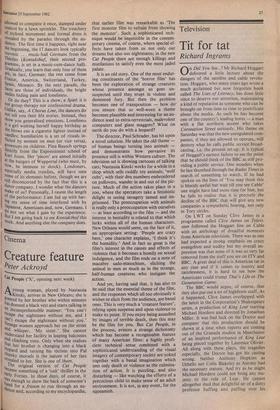Cinema Creature feature
Peter Ackroyd
AYoung woman, played by Nastassia Kinski, arrives in New Orleans; she is has by her brother who within minutes nas donned a black vest and starts talking in all incomprehensible manner: `You can't escape the nightmare without me, and I can't escape the nightmare without you.' "Itra n , ge women approach her on the street an whisper, `My sister.' She cannot understand her facility in leaping balconies and climbing trees. Only when she realises that her brother is changing into a black leopard and turning his victims into Pal chunky morsels is the nature of her fate revealed to her. She is one of them. k The original version of Cat People became something of a `cult' thriller in the early Forties. In those days, of course, it was enough to show the back of someone's has
for a frisson to run through an au- `nence and, according to my encyclopaedia, that earlier film was remarkable as `The first monster film to refrain from showing the monster'. Such a sophisticated tech- nique would be impossible in the contem- porary cinema, of course, where special ef- fects have taken from us not only our dreams but also our nightmares; in the new Cat People there are enough killings and mutilations to satisfy even the most jaded palate.
It is an old story. One of the most endur- ing constituents of the `horror film' has been the exploration of strange creatures whose presence amongst us goes un- suspected until they erupt in violent and demented fury. But then the problem becomes one of transposition — how do' you ensure that so well-worn a theme becomes plausible and interesting for an au- dience used to extra-terrestrials, malevolent computers and giant maggots? What on earth do you do with a leopard?
The director, Paul Schrader, has hit upon a novel solution. He takes the old theme of human beings turning into animals and demonstrates how pervasive its presence still is within Western culture. The television set is showing cartoons of talking cats; Nastassia Kinski works for a while in a shop which sells cuddly toy animals; `wolf cubs', with their den numbers embroidered on pullovers, wander in and out of the pic- ture. Much of the action takes place in a zoo, where the spectators take a fetishistic delight in seeing savagery tamed and im- prisoned. The preoccupation with animals is really only a preoccupation with ourselves — at least according to the film — and the interest in bestiality is related to that which lurks within all of the human characters. New Orleans would seem, on the face of it, an appropriate setting: `People are crazy here,' one character explains, `I think it's the humidity.' And in fact so great is the film's interest in the causes and effects of violence that it becomes a homily on sexual indulgence, and the film ends on a note of macabre sado-masochism, eliciting the animal in men as much as in the strange, half-human creatures who instigate the action.
And yet, having said that, it has also to be said that the essential theme of the film, and the responses which all too obviously it wishes to elicit from the audience, are banal ones. This is very much a `creature feature', relying upon suspense and upon violence to make its point. If you enjoy being assaulted by images of terrible death, then this may be the film for you. But Cat People, in the process, evinces a strange dichotomy which has become a recognisable feature of many American films: a highly profi- cient technical sense combined with a sophisticated understanding of the visual imagery of contemporary society are yoked together with a banal imagination which sees only death or violence as the culmina- tion of action. It is puzzling, and also disturbing — like watching the efforts of a precocious child to make sense of an adult environment. It is not, in any event, for the squeamish.


































 Previous page
Previous page